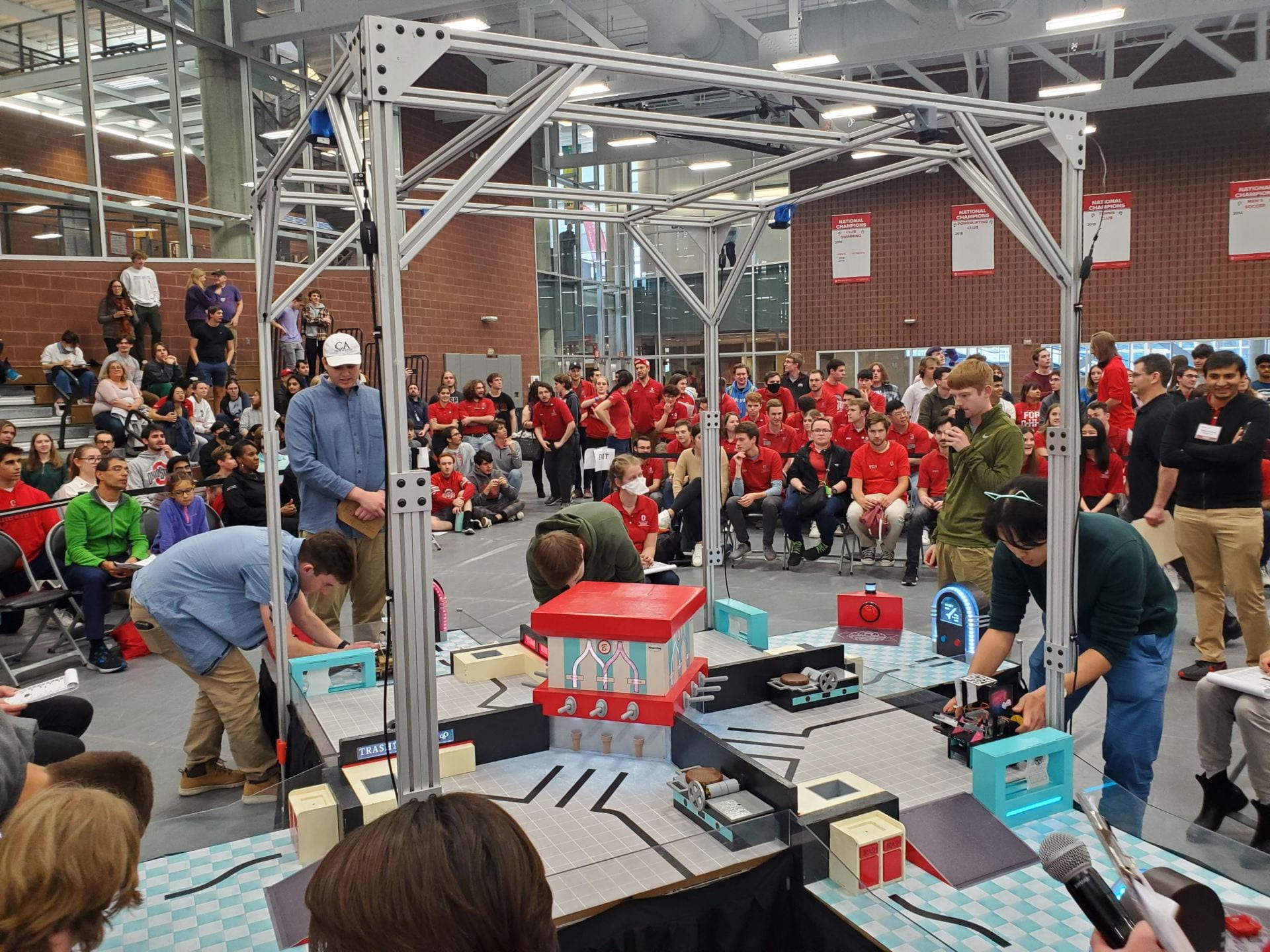
The final four teams compete in the last round of the single-elimination tournament during the annual Fundamentals of Engineering for Honors Program Robot Competition. Credit: Courtesy of Bridgette Wadge
Over 220 first-year engineering honors students gathered at the RPAC Saturday to design, build and program robots to complete specific tasks.
At the 26th annual Fundamentals of Engineering for Honors Robot Competition, students were divided into 57 four-member teams to prepare a fully autonomous robot vehicle capable of completing a series of food service tasks.
The teams’ robots faced off in a scale-model of a 1950s diner, dubbed “Carmen’s Diner,” in two rounds — a round-robin competition followed by a single-elimination tournament, according to the event’s website. The robots were given two minutes to perform tasks such as flipping burgers, serving ice cream and playing songs on a jukebox.
Team E7, named Impossible Robotics, took first place in both the round-robin and single-elimination tournaments, earning each team member a $250 scholarship. Jasper Reckamp, a first-year in environmental engineering and one of the winning team’s members, said they were grateful for their victory given the tough competition.
“They released the individual competition times and scores about a week before the final competition, so we knew that there was a team that was 20 seconds ahead of us,” Reckamp said. “They had a mishap in the first round, so we never actually faced them today — they might have beat us if not.”
Impossible Robotics had four members: Reckamp; Jacob McLachlan, a first-year in computer science and engineering; Tommy Polakowski, a first-year in mechanical engineering; and Brandon Young, a first-year in electrical and computer engineering. Reckamp said the team formed as part of the College of Engineering’s “Fundamentals of Engineering for Honors” robotics course.
The “Fundamentals of Engineering for Honors” course is an optional class offered to University Honors-designated engineering students, according to the College of Engineering website. The program is designed to teach students engineering principles necessary for success throughout their academic careers through numerous ways, including Saturday’s event.
Students self-selected teams to take part in the competition and were given six hours of class time per week to work on the robots for nine weeks leading up to the competition. McLachlan said although the teams weren’t required to put in much time outside the classroom, it was necessary to perform well.
“We probably spent about twice as long out of class working on it as in class,” McLachlan said. “It was like a full-time job the last few weeks, but it paid off.”
Bridgette Wadge, a fourth-year in mechanical engineering and an undergraduate teaching assistant for the “Fundamentals of Engineering for Honors” course, said the course is involved in planning the competition.
“The course is entirely designed and built by teaching assistants,” Wadge said. “Graduate and undergraduate teaching assistants work on it throughout the year.”
Wadge said the competition required nearly a full academic year of planning, and the competition’s course and tasks were designed during the fall semester before being revealed to the students in January. The students then had from late January until Saturday to design, build and program their robots.
Victor Stettler, a first-year in computer science and engineering and a participant in the event, said the process of designing and building a robot was gratifying.
“The teamwork aspect has been hugely important for everyone,” Stettler said. “I’ve taken a lot away from building on the software and the kind of experience of what it’s like to develop over a long period of time in a high-stress environment.”
Ray Cowen, a graduate assistant who helped organize the event, said something they hope students take away from the event is the importance of teamwork and refining ideas as they work — an important aspect of engineering.
“As well as looking back at how much they’ve been able to do over this short period of time and take pride in their work,” Cowen said. “We’re remarkably impressed with everything they’ve been able to do.”


